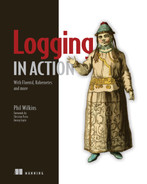Part 2. Fluentd in depth
In part 1, we introduced Fluentd and Fluent Bit, we explored what drives the adoption of these tools, and we covered the problems both Fluentd and Fluent Bit are best suited to address. We also took the time to understand the differences between Fluentd and Fluent Bit. From here on, we will focus primarily on Fluentd.
In the following part, we will dig into what Fluentd can do and how to configure it. In doing so, we’ll tackle some scenarios that most users will likely encounter sooner or later—for example, how to capture log events from a log file as they are added by another log application, including handling challenges such as log rotation. Chapter 3 starts with capturing log events, focusing on sources such as files, as this is one of the most common sources of log events. Chapter 4 takes us into storing log events in different destinations, such as databases and social/collaboration tools. This includes dealing with the parsing and formatting of events. Chapters 5 and 6 show the different aspects of log event routing, duplication, and log attribute injection.
By the end of part 2, we will have covered enough ground for you to build configurations for most use cases. This allows us to go into part 3, where we will focus on the challenges of Docker, Kubernetes, scaling, performance, and use cases requiring specialist plugins.
